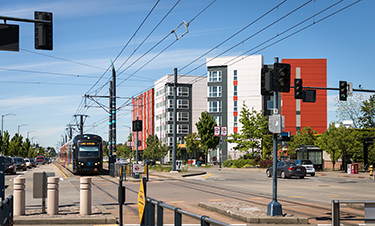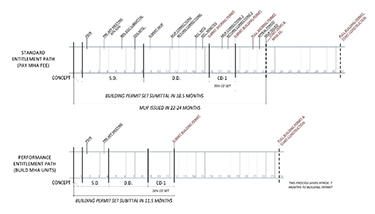|
Subscribe / Renew |
|
|
Contact Us |
|
| ► Subscribe to our Free Weekly Newsletter | |
| home | Welcome, sign in or click here to subscribe. | login |
Architecture & Engineering
| |
 |
February 29, 2024
Bypassing review to boost affordability
Ankrom Moisan

Kelley
|
Seattle, like many other urban environments across the United States, still grapples with meeting the rising demand for affordable housing to support the needs of low-income families and individuals. The 2022 Annual Homelessness Assessment Report concluded that over 13,000 people in King County were experiencing homelessness, a staggering number that points to a need for radical change.
While other temporary fixes have been proposed and implemented, the city council’s latest amendment to the land use code makes two important changes to the public design review process aimed at encouraging additional low-income housing. The first change permanently exempts low-income housing projects from the design review process. The second change provides a new design review exemption for projects that fulfill Mandatory Housing Affordability (MHA) requirements by offering on-site units through the Performance Option under the Land Use Code. By encouraging developers to build affordable units within market-rate buildings, a greater number of housing options will arise, providing shelter sooner for vulnerable populations.
Currently, most developers pay a fee in place of providing affordable units onsite. Now there is an incentive to incorporate this component into any market-rate project, leading to greater options available sooner for those in need. This new exemption under the Land Use Code, administered by the Seattle Department of Construction & Inspections (SDCI), allows projects that have opted into the Performance Option to skip the Seattle entitlement process called the Master Use Permit (MUP) including design review and proceed directly to building permit submittal.
This change could save a project six to seven months from project start to construction date, and allows projects to begin construction in 14-18 months, or even faster, based on the construction phasing chosen by the development team.
While designers and architects can conceive and execute plans on a consistent timeline, there are often external factors that can hinder any given project. Receiving permits and approvals from the city is a necessary part of maintaining proper integrity and standards, but disrupts the linear process. The elimination of the design review process allows for a more seamless transition from design to construction to completion, meaning more units can hit the market and more quickly contribute to efforts to remedy the lack of housing.
While SDCI staff can move quickly, other city departments can still impact permitting timelines. The Seattle Department of Transportation (SDOT), for example, may still place holds on project building permit submittals. Design teams must engage in the Street Improvement (SIP) process as soon as possible. Both the landscape architect and civil engineer need to be engaged early and share the expedited schedule with SDOT staff.
SDOT staff have the authority to waive the building permit submittal hold, but need to have confidence that the project will meet the city’s street improvement requirements. Additionally, Seattle City Light (SCL) will not expedite any processes, and can delay construction and project opening dates. It is critical that the design electrical engineer is engaged early to create the service letter application and can attend the pre-application meeting with the necessary design information.
A significant amendment in the land use code, removing the public design review process, implies a reduced risk of unexpected impacts. Fees and the quantities of on-site units are listed in the land use code, and can be computed by the design team. The developer can then weigh the time and risk reduction with the elimination of the design review process with the requirements for the on-site units.
However, on-site affordable housing units provided to satisfy the requirements of the Performance Option cannot be used to earn public subsidies such as through the Multifamily Housing Property Tax Exemption (MFTE Program). This is an important consideration as many developers leverage the savings provided by MFTE program. Navigating these intricate requirements demands an experienced design team, but successful implementation can yield significant time savings for development teams.
Ultimately, every stride toward producing affordable housing and addressing the current shortage is an enhancement of the existing framework. If the objective is to change, then new ideas and amendments become essential. The opportunity to bypass such a complicated aspect of the overall design and construction process will be transformative in how housing projects are conceived and executed.
Architects and designers are excited to engage in new projects and see how this amendment will be of use since rectifying the high rate of homelessness in Seattle is a top priority for all who live here. As with any new regulations, challenges and questions may require creative solutions and patience, all contributing to a more seamless process going forward. Utilizing the resources available, continuing to conduct community outreach, and maintaining an open dialogue with developers and city officials will create a collaborative environment geared toward changing the housing landscape for the better.
David Kelley is the co-director of the housing studio and a senior principal in Ankrom Moisan’s Seattle office, specializing in multifamily housing design across the West.
Other Stories:
- The need for high-performance building enclosure design
- Designing library spaces for the children of today
- Seattle’s commercial development at a crossroads
- Designing for health in affordable housing
- Disrupting inequality in housing
- Trends transforming life-science building design
- Eight trends shaping design for cities in 2024
- Centering the patient and community in rural healthcare design
- Engineering with support from the sky
- Transforming yesterday’s spec office into the destination workplace of tomorrow
- An uncertain forecast for middle housing




